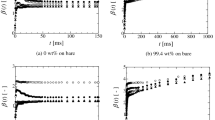Abstract
Direct numerical simulations of liquefied metal nanostructures dewetting a substrate are carried out. Full three-dimensional Navier–Stokes equations are solved and a volume-of-fluid method is used for tracking and locating the interface. Substrate wettability is varied to study the influence of the solid–liquid interaction. The effects of initial geometry on the retraction dynamics is numerically investigated. It is shown that the dewetting velocity increases with increases in the contact angle and that the retraction dynamics is governed by an elaborate interplay of initial geometry, inertial and capillary forces, and the dewetting phenomena. Numerical results are presented for the dewetting of nanoscale Cu and Au liquefied structures on a substrate.













Similar content being viewed by others
References
Habenicht A, Olapinski M, Burmeister F, Leiderer P, Boneberg J (2005) Jumping nanodroplets. Science 309:2043
Boneberg J, Habenicht A, Benner D, Leiderer P, Trautvetter M, Pfahler C, Plettl A, Ziemann P (2008) Jumping nanodroplets: a new route towards metallic nano-particles. Appl Phys A 93:415
Roberts NA, Fowlkes JD, Mahady K, Afkhami S, Kondic L, Rack PD (2013) Directed assembly of one- and two-dimensional nanoparticle arrays from pulsed laser induced dewetting of square waveforms. ACS Appl Mater Interfaces 5:4450
Fuentes-Cabrera M, Rhodes BH, Fowlkes JD, López-Benzanilla A, Terrones H, Simpson ML, Rack PD (2011) Molecular dynamics study of the dewetting of copper on graphite and graphene: implications for nanoscale self-assembly. Phys Rev E 83:041603
Fuentes-Cabrera M, Rhodes BH, Baskes MI, Terrones H, Fowlkes JD, Simpson ML, Rack PD (2011) Controlling the velocity of jumping nanodroplets via their initial shape and temperature. ACS Nano 5:7130
de Gennes PG (1985) Wetting: statics and dynamics. Rev Mod Phys 57:827
Haley PJ, Miksis MJ (1991) The effect of the contact line on droplet spreading. J Fluid Mech 223:57
Trice J, Thomas D, Favazza C, Sureshkumar R, Kalyanaraman R (2007) Pulsed-laser-induced dewetting in nanoscopic metal films: theory and experiments. Phys Rev B 75:235439
Ajaev VS, Willis DA (2003) Thermocapillary flow and rupture in films of molten metal on a substrate. Phys Fluids 15:3144
Kondic L, Diez J, Rack P, Guan Y, Fowlkes J (2009) Nanoparticle assembly via the dewetting of patterned thin metal lines: understanding the instability mechanism. Phys Rev E 79:026302
Afkhami S, Bussmann M (2008) Height functions for applying contact angles to 2D VOF simulations. Int J Numer Method Fluids 57:453
Afkhami S, Bussmann M (2009) Height functions for applying contact angles to 3D VOF simulations. Int J Numer Method Fluids 61:827
Afkhami S, Zaleski S, Bussmann M (2009) A mesh-dependent model for applying dynamic contact angles to VOF simulations. J Comput Phys 228:5370
Hirt CW, Nichols BD (1981) Volume of fluid VOF method for the dynamics of free boundaries. J Comput Phys 39:201
Gueyffier D, Li J, Nadim A, Scardovelli R, Zaleski S (1999) Volume-of-fluid interface tracking and smoothed surface stress methods for three-dimensional flows. J Comput Phys 152:423
Brackbill JU, Kothe DB, Zemach C (1992) A continuum method for modeling surface tension. J Comput Phys 100:335
Sussman M (2003) A second order coupled level set and volume-of-fluid method for computing growth and collapse of vapor bubbles. J Comput Phys 187:110
Cummins SJ, Francois MM, Kothe DB (2005) Estimating curvature from volume fractions. Comput Struct 83:425
Francois MM, Cummins SJ, Dendy ED, Kothe DB, Sicilian JM, Williams MW (2006) A balanced-force algorithm for continuous and sharp interfacial surface tension models within a volume tracking framework. J Comput Phys 213:141
Popinet S (2003) Gerris: a tree-based adaptive solver for the incompressible Euler equations in complex geometries. J Comput Phys 190:572
Bell JB, Colella P, Glaz HM (1989) A second-order projection method for the incompressible Navier–Stokes equations. J Comput Phys 85:257
Young T (1805) An essay on the cohesion of fluids. Philos Trans R Soc Lond 95:65–87
Afkhami S, Kondic L (2013) Numerical simulation of ejected molten metal nanoparticles liquified by laser irradiation: interplay of geometry and dewetting. Phys Rev Lett 111:034501
González AG, Diez JA, Kondic L (2013) Stability of a liquid ring on a substrate. J Fluid Mech 718:246
Mahady K, Afkhami S, Diez J, Kondic L (2013) Comparison of Navier–Stokes simulations with long-wave theory: study of wetting and dewetting. Phys Fluids 25:112103
Acknowledgments
The results presented here are a part of a larger research project involving Kyle Mahady (New Jersey Institute of Technology), Javier Diez and Alejandro Gonzalez from Universidad Nacional del Centro de la Provincia de Buenos Aires (Argentina), and Jason Fowlkes, Miguel Fuentes-Cabrera, and Philip Rack from Oak Ridge National Laboratory and the University of Tennessee. We acknowledge the extensive discussions with all members of the research team. This work was supported in part by National Science Foundation Grants DMS-1320037 (S.A.) and CBET-1235710 (L.K.).
Author information
Authors and Affiliations
Corresponding author
Rights and permissions
About this article
Cite this article
Afkhami, S., Kondic, L. On the dewetting of liquefied metal nanostructures. J Eng Math 94, 5–18 (2015). https://doi.org/10.1007/s10665-013-9685-y
Received:
Accepted:
Published:
Issue Date:
DOI: https://doi.org/10.1007/s10665-013-9685-y




